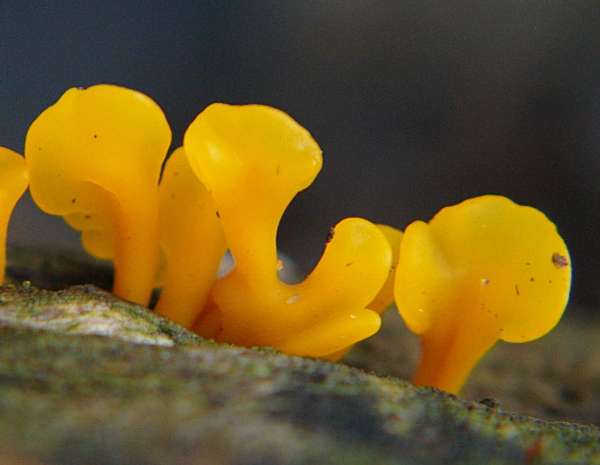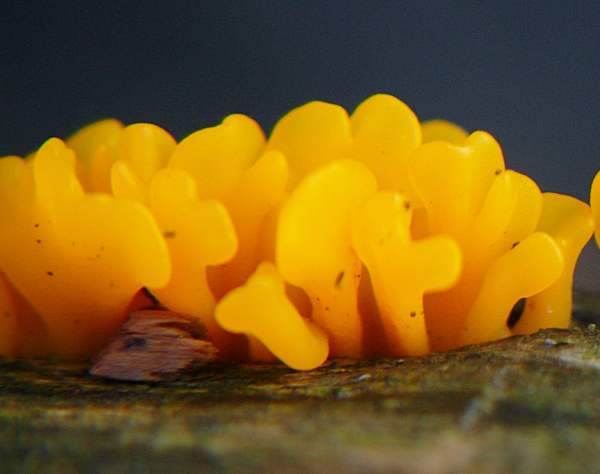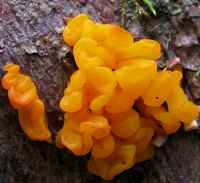Trees Birds Mammals Fish Amphibians Reptiles
Wild Algarve
Bookshop
Dacrymyces chrysospermus (Bull.) Tul. - Orange Jelly Spot
Phylum: Basidiomycota - Class: Dacrymycetes - Order: Dacrymycetales - Family: Dacrymycetaceae
Distribution - Taxonomic History - Etymology - Identification - Reference Sources

Gregarious or in merging groups on dead conifer wood, including fence posts and rails, this rather uncommon fungus has a preference for timber that is already fairly well rotted.
The fruitbodies can appear at any time of the year during periods of wet weather; this is not a very helpful identification feature, however, as it is a characteristic shared with many of the other members of the order Dacrymycetales.
Distribution
Very rarely recorded in Britain, Dacrymyces chrysospermus is much more common and widespread in North America.

Taxonomic history
In 1873 this fungus was described by British Mycologist Miles Joseph Berkley (1803 - 1889) and New Zealander Moses Ashley Curtis, who gave it the name Dacrymyces chrysospermus; this remains its generally-accepted scientific name.
Synonyms of Dacromyces chrysospermus include Tremella palmata Schwein., and Dacrymyces palmatus (Schwein.) Bres.
Etymology
Set up by Nees in 1816, the genus Dacrymyces is named from Dacry- meaning a tear (as in weeping) and -myces meaning fungus, while the specific epithet chrysospermus comes from Chrys- meaning golden and -spermus meaning seed. (The spores of this fungus are indeed yellow when seen in mass.)
Identification guide
 |
Fruitbody
Orange-yellow, but almost white at the point of attachment, becoming reddish-brown and more translucent when dry; irregularly lobed or brain-like blobs, slightly flattened; 1 to 2.5cm tall and up to 6cm wide. |
| |
Spores
Sausage-shaped, smooth, thin-walled, 18-23 x 6.5-8µm; 7-septate to 9-septate (spores developing 7 to 9 cross walls) at maturity.
Spore mass
Pale yellow. |
Odour/taste |
Not distinctive. |
Habitat & Ecological role |
On rotting trunks and stumps of dead conifers. |
Season |
Fruiting from spring to the onset of winter. |
Similar species |
Dacrymyces stillatus, another orange jelly-like species, produces smaller, cushion-like fruitbodies and occurs on hardwoods as well as softwoods.
Tremella mesenterica produces fruitbodies of similar colour but the lobes are often larger and generally more convoluted; its spores are white. |
Reference Sources
Fascinated by Fungi, 2nd Edition, Pat O'Reilly 2016, reprinted by Coch-y-bonddu Books in 2022.
Dictionary of the Fungi; Paul M. Kirk, Paul F. Cannon, David W. Minter and J. A. Stalpers; CABI, 2008
Taxonomic history and synonym information on these pages is drawn from many sources but in particular from the British Mycological Society's GB Checklist of Fungi.
Acknowledgements
This page includes pictures kindly contributed by Doug Holland.
Top of page...
Fascinated by Fungi. Back by popular demand, Pat O'Reilly's best-selling 450-page hardback book is available now. The latest second edition was republished with a sparkling new cover design in September 2022 by Coch-y-Bonddu Books. Full details and copies are available from the publisher's online bookshop...